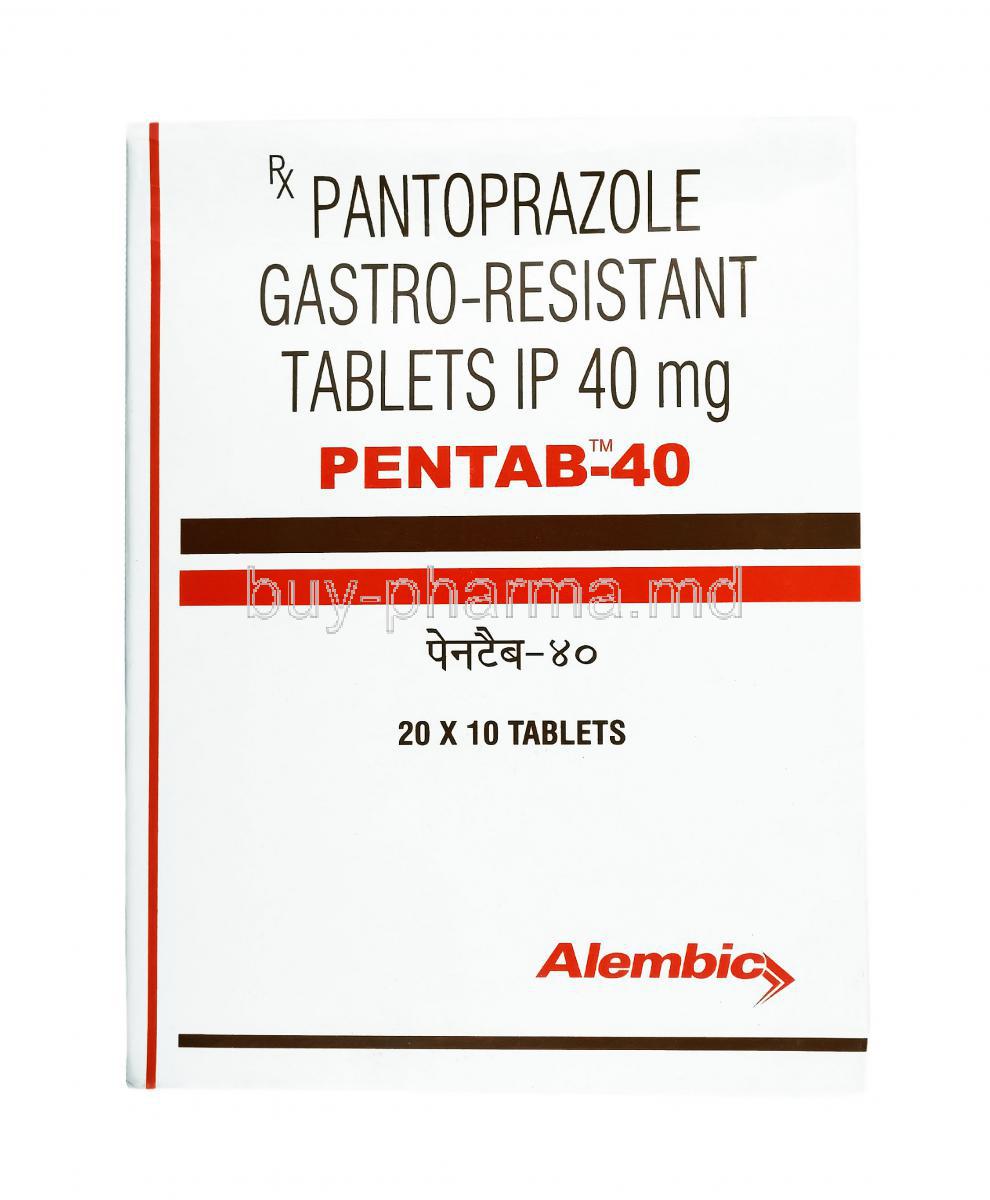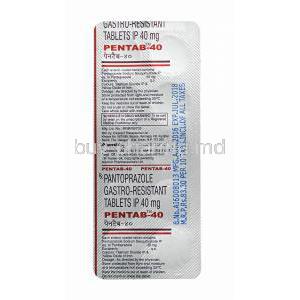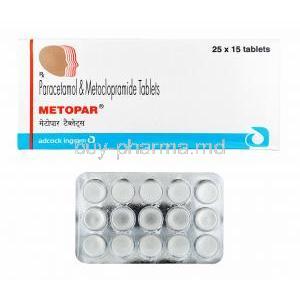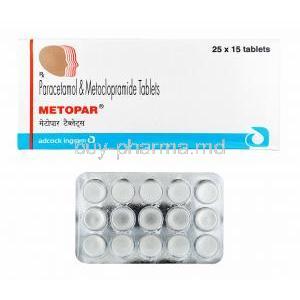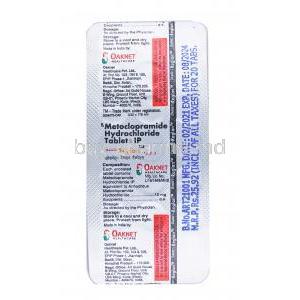Pentab, Pantoprazole
- Introduction to Pentab, Pantoprazole
- Uses of Pantoprazole
- Off-Label Uses of Pantoprazole
- Dosage and Administration
- Side Effects of Pantoprazole
- Interactions with Other Medications
- Warnings and Contraindications
- Administration in Special Populations
- Overdosage of Pantoprazole
- Important Precautions
- Storage and Handling Precautions
- Careful Administration
Introduction to Pentab, Pantoprazole
Pantoprazole, a medication sold as Pentab is a component in the treatment of acid-related gastrointestinal disorders. It represents the combination of innovative chemistry and effective therapy providing much-needed relief to countless individuals dealing with conditions like GERD and Zollinger-Ellison syndrome. Its introduction to the field has not only transformed how we address acid-related ailments but has also emphasized the significance of targeted treatment, in modern medicine.
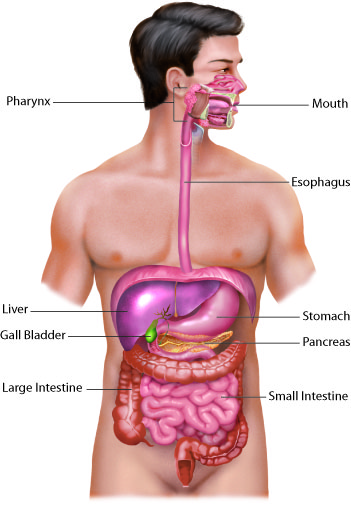
Digestive System
Overview of Pantoprazole
The story of Pantoprazole is a tale of curiosity, thorough research, and its eventual application in the medical field. Originally created in the 20th century Pantoprazole belongs to a category of medications called proton pump inhibitors (PPIs).
Its main purpose is to inhibit the gastric proton pump, which effectively reduces the secretion of acid. This pharmacological action has made it an essential tool in treating ulcers, GERD, and other acid-peptic diseases.
- Historical Development; The journey of Pantoprazole from its creation in the laboratory to becoming used in clinical practice marks a significant milestone in pharmaceutical development. Its discovery was driven by the need for effective and safer alternatives to existing therapies that suppress acid production.
- Importance in Modern Medicine; Pantoprazole's role extends beyond relieving symptoms; it aids in healing erosive esophagitis prevents peptic ulcers in patients taking chronic NSAID therapy and plays a crucial part in treatment regimens, eradicating Helicobacter pylori infection.
Composition of Pantoprazole
The effectiveness of Pantoprazole as an option reflects its complex composition, which includes both active and inactive components to ensure its efficiency and reliability. Each tablet is a feat of pharmaceutical engineering designed to deliver the active ingredient effectively while minimizing potential side effects.
- Active Ingredients; Pantoprazole sodium, the ingredient in this medication directly targets the H+/K+ ATPase enzyme system on the surface of gastric parietal cells as a proton pump inhibitor.
- Inactive Ingredients and Their Roles; Alongside the ingredients various excipients such, as sodium carbonate, mannitol and magnesium stearate are included to support the drugs stability, bioavailability and acceptance by patients.
- Variants and Formulations; Pantoprazole is offered in forms including delayed release tablets and intravenous injections to cater to diverse clinical requirements and patient preferences.
How Pantoprazole Works
The way Pantoprazole works is quite interesting and intricate. It specifically. Inhibits an enzyme called H+/K+ ATPase, which is the final step in the process of gastric acid secretion. As a result, it causes a decrease in the production of gastric acid.
- Mechanism of Action; Pantoprazole binds to certain cysteine residues found on the gastric proton pump leading to a sustained suppression of gastric acid secretion. This helps in healing the mucosal lining. Provides relief from symptoms.
- Effect on Gastric Acid Secretion; The reduction in acidity helps prevent damage caused by acid to the stomach and esophageal lining thus alleviating symptoms and promoting tissue healing.
- Pharmacokinetics and Pharmacodynamics; Pantoprazole has a pharmacokinetic profile with fast absorption, and widespread distribution throughout tissues and is primarily metabolized through the cytochrome P450 system. This ensures therapeutic effects while minimizing adverse reactions.
In conclusion, Pantoprazole represents progress in gastroenterological therapy. It is crucial for healthcare professionals to have an understanding of this medication to optimize treatment outcomes, for patients dealing with acid-related gastrointestinal disorders.
Uses of Pantoprazole
It does more than relieve symptoms; it also provides therapeutic benefits, for various gastrointestinal conditions. This article explores the different uses of Pantoprazole focusing on its main purposes, preventive applications, and other therapeutic benefits.
1. NCBI - Pantoprazole
Primary Indications: Gastroesophageal Reflux Disease (GERD), Peptic Ulcers, and Zollinger-Ellison Syndrome
The main reasons to use Pantoprazole are for three conditions that are all related to the overproduction of stomach acid.
- One of these conditions is Gastroesophageal Reflux Disease (GERD)(1) which occurs when stomach acid flows back into the esophagus. Pantoprazole helps improve GERD by reducing the damage to the esophagus and providing relief from symptoms.
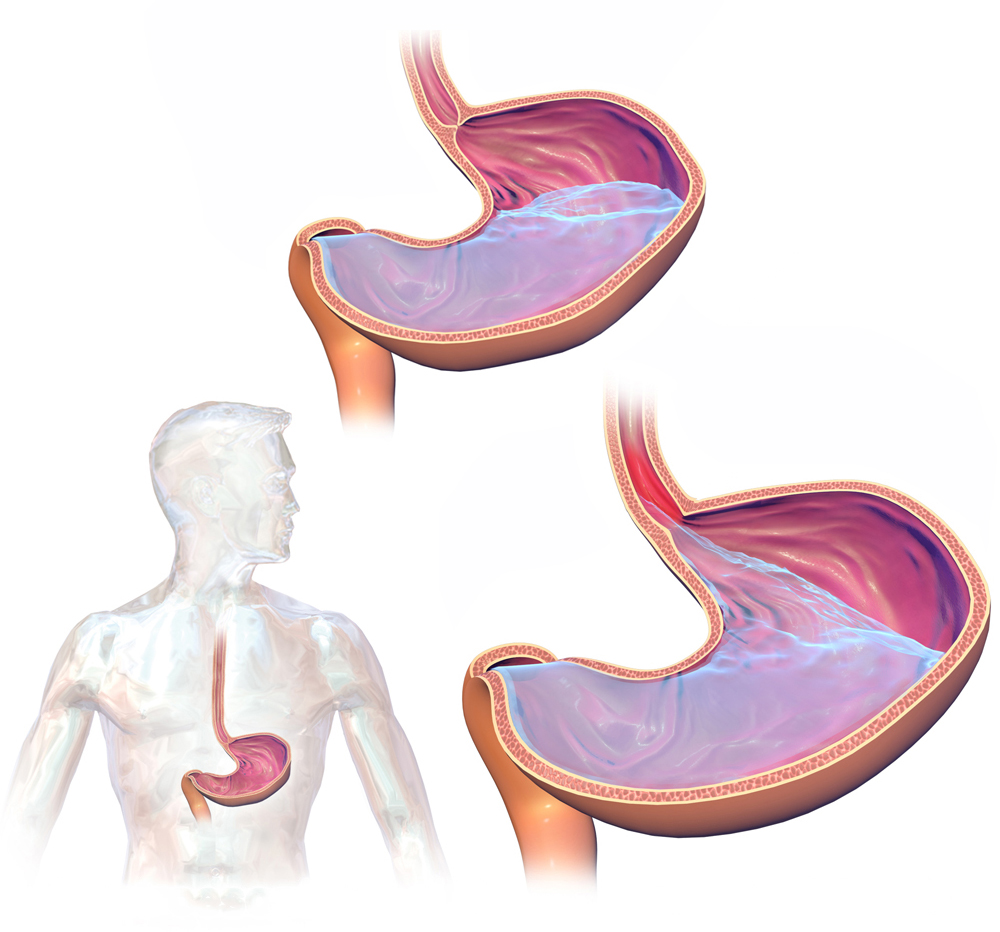
GERD
- Another condition that benefits from Pantoprazole is ulcers(2), which are caused by erosion in the lining of either the stomach or duodenum. Pantoprazole's ability to suppress acid production creates an environment that promotes healing and prevents ulcers from getting worse.

Peptic Ulcer
- Lastly, Zollinger-Ellison Syndrome, a condition characterized by the secretion of stomach acid requires strong acid inhibition provided by Pantoprazole. It effectively Controls the excessive production of acid preventing potential complications.
The effectiveness of Pantoprazole in treating these conditions highlights its significance, in addressing disorders related to excess acidity.
1. NCBI - An update on the use of pantoprazole as a treatment for gastroesophageal reflux disease
2. NHS - Pantoprazole
3. Science Direct - Maintenance oral pantoprazole therapy is effective for patients with Zollinger-Ellison syndrome and idiopathic hypersecretion
Prophylactic Use in NSAID-Induced Ulcers
Nonsteroidal Anti Inflammatory Drugs (NSAIDs) although they offer pain relief and reduce inflammation carry a risk of causing ulcers in the gastrointestinal tract. Pantoprazole acts as a measure helping to prevent the formation of gastric and duodenal ulcers caused by NSAID use. The use of pantoprazole for prevention highlights the importance of pharmacotherapy, in protecting the stomach lining while continuing to use NSAIDs.
Additional Therapeutic Applications
Apart from its preventive functions, Pantoprazole demonstrates versatility in treating various gastrointestinal disorders. Its effective role in managing Dyspepsia and laryngopharyngeal Reflux (LPR) and as a supplement to eradication treatments for Helicobacter pylori infection expands its possibilities.
The drug's usefulness in these conditions showcases its adaptability and its ability to address a range of acid-related gastrointestinal pathologies. In summary, the diverse applications of Pantoprazole in the field of gastroenterology highlight its role in managing acid-related disorders.
Whether it's providing relief for GERD preventing ulcers caused by NSAIDs or addressing a spectrum of gastrointestinal issues Pantoprazole exemplifies the progress made in medical pharmacotherapy. Its comprehensive utility not only improves patient care but also emphasizes the significance of targeted therapeutic interventions, in gastroenterology.
Off-Label Uses of Pantoprazole
Pantoprazole is a known medication used to treat gastroesophageal reflux disease (GERD) and peptic ulcers. However, it is also utilized for off-label purposes. These additional uses take advantage of Pantoprazole's ability to reduce stomach acid and help with conditions that go beyond its approved indications. This showcases the versatility of Pantoprazole, in the field of gastroenterology.
Treatment of Stress Ulcer Prophylaxis in ICU Patients
Ill individuals in intensive care units (ICUs) face an increased likelihood of developing stress-related mucosal disease, which can have significant negative impacts on their health and even lead to death. Pantoprazole is being recognized as a measure to hinder the formation of stress ulcers. Its effectiveness in reducing stomach acid production makes it a preferred choice for minimizing the risk of bleeding in these vulnerable patients. The use of Pantoprazole in this context highlights the importance of taking an approach when managing critically ill patients with a focus, on preventing potential complications.
Management of Dyspepsia
Dyspepsia presents a treatment challenge as it causes chronic or recurring discomfort in the upper abdomen. When dyspeptic symptoms point towards an acid-related cause Pantoprazole is sometimes used, off-label to address them. By doing the drug can help relieve discomfort and enhance the overall quality of life for individuals dealing with persistent upper gastrointestinal issues.
Use in Eosinophilic Esophagitis
Eosinophilic Esophagitis (EoE) is a disorder of the esophagus where eosinophils infiltrate and it often has symptoms similar to GERD. Although Pantoprazole isn't a primary treatment for EoE its sometimes prescribed off-label to help manage acid reflux symptoms that can coexist or worsen EoE. This approach stresses the significance of effectively managing symptoms in conditions, with intricate causes.
Potential Applications in Barrett's Esophagus
Barrett's esophagus is a condition that occurs when the lining of the esophagus is replaced with tissue resembling that of the intestines. It typically develops as a complication of GERD and increases the risk of esophageal adenocarcinoma.
The use of Pantoprazole for this purpose although not officially approved is based on its ability to reduce acid production.
This may potentially slow down the progression of Barrett's Esophagus. Lower the chances of developing esophageal cancer. This expanded application highlights Pantoprazole's role in managing gastrointestinal conditions going beyond just relieving symptoms.
To sum up, Pantoprazole has off-label uses that go beyond its approved indications. It serves as a tool for clinicians in managing various gastroenterological conditions.
Whether it preventing stress ulcers in ill patients treating dyspepsia or potentially slowing down conditions like Eosinophilic Esophagitis and Barretts Esophagus Pantoprazole proves to be an important option, in modern gastroenterology practice.
Dosage and Administration
Recommended Dosages for Different Conditions
Administering Pantoprazole requires consideration taking into account the individual's specific condition and severity. When treating Gastroesophageal Reflux Disease (GERD) the recommended dosage is 40 mg per day for a duration of up to 8 weeks.
However managing Zollinger-Ellison Syndrome may require doses potentially exceeding 160 mg, per day which should be adjusted based on the patient's acid output measurements. This demonstrates how the dosing of this medication can be tailored to meet therapeutic requirements.
Dosage Adjustments for Specific Populations
It is crucial to make adjustments for Pantoprazole in certain groups, such as individuals with liver problems and older patients. Individuals, with liver dysfunction should take a lower dosage to prevent any potential buildup of the medication and reduce the chance of negative effects. These adjustments emphasize the significance of tailoring treatment to each person's needs ensuring it is effective but also minimizing any harm.
Administration Techniques and Timing
The ways in which Pantoprazole is administered can differ, with options, like taking it through an intravenous route. These different methods cater to the needs and severity of the patient's condition.
To ensure absorption and effectiveness it is recommended to take Pantoprazole orally before a meal, usually around 30 minutes prior. This approach aims to optimize the drug benefits by aligning its pharmacokinetics with the cycles of gastric acid production.
Side Effects of Pantoprazole
Common Side Effects: Headache, Diarrhea, Nausea, and Abdominal Pain
Although Pantoprazole is generally well tolerated it can still cause side effects. Some of the adverse reactions include ;
- Headaches
- Diarrhea
- Nausea
- Abdominal pain.
However, these effects are usually temporary. Can be managed effectively. These side effects occur due to the drug's influence on the system so it's important to monitor patients closely to ensure their comfort and adherence, to treatment.
There are worrisome issues associated with Pantoprazole such as its connection to hypomagnesemia Clostridium difficile infection and an increased likelihood of fractures related to osteoporosis when used for a long time.
These significant side effects require observation and possibly proactive steps emphasizing the delicate balance, between the advantages of treatment and the potential risks involved.
Long-term Use Considerations
When using Pantoprazole for a period of time it is important to weigh the possible risks, against the benefits. It is crucial to assess and use the medication carefully aiming for the lowest effective dose and shortest duration possible to minimize any potential side effects.
Interactions with Other Medications
Common Drug Interactions and Their Management
Impact on Absorption of Other Drugs
Pantoprazole has the potential to influence the absorption of medications like ketoconazole and atazanavir by changing the acidity level in the stomach. It is important to be aware of and manage these interactions carefully in order to ensure that therapeutic drug levels are maintained and that the medications work effectively.
Recommendations for Co-administration
When combining Pantoprazole with medications it's important to take a careful approach. This involves considering interactions and how they may affect the absorption of the drugs. Recommendations often include adjusting timing or monitoring plasma concentrations to ensure that the medications work effectively and safely together.
This approach helps ensure that patients receive the possible outcomes when taking Pantoprazole alongside other drugs.
In summary, administering Pantoprazole can be complex. Healthcare professionals follow a framework that prioritizes personalized care. By managing dosages monitoring for side effects and addressing any drug interactions they can optimize the therapeutic benefits of Pantoprazole in treating acid-related disorders.
Warnings and Contraindications
Contraindications: Hypersensitivity and Specific Health Conditions
Pantoprazole should not be used by patients who have a known allergy or hypersensitivity to the drug or any of its components. This could lead to reactions such as anaphylaxis, urticaria, or other allergic responses. Furthermore, individuals with health conditions like severe liver impairment may be advised against using pantoprazole due, to the possibility of increased side effects or reduced elimination of the drug.
Black Box Warnings if Any
According to the medical guidelines Pantoprazole is not associated with a Black Box Warning. However, healthcare providers are advised to stay alert for any updates, from bodies regarding potential warnings that may be added based on new clinical evidence.
Special Populations: Elderly, Pregnant Women, Nursing Mothers, and Children
When prescribing Pantoprazole it is important to be cautious and considerate when dealing with populations. The elderly might need adjustments in their dosage to minimize any negative effects. For women and nursing mothers, it is necessary to carefully weigh the possible benefits against the risks as there isn't enough conclusive data about its safety in these groups. When it comes to children the use and dosage of Pantoprazole should be based on evidence and indications, for pediatric patients.
Administration in Special Populations
Elderly: Adjustments and Considerations
As people get older changes in how their bodies handle medications can impact how drugs are processed and eliminated. Because of this, it may be necessary for doctors to make adjustments to the dosage or closely monitor for any side effects. Healthcare professionals should prioritize an approach by starting treatment with the smallest effective dose to find the right balance, between effectiveness and safety.
Pregnant Women and Nursing Mothers: Safety and Recommendations
It is advisable to consider administering Pantoprazole during pregnancy and breastfeeding when the potential benefits outweigh the possible risks to the baby. It is important to make decisions based on up-to-date research findings and clinical guidelines in order to prioritize the health of both the mother and child.
Children: Dosage Adjustments and Safety
When it comes to children healthcare professionals need to be cautious about the dosage and how Pantoprazole is given. They should consider factors like age, weight, and the specific condition being treated. The safety and effectiveness of Pantoprazole, in patients are constantly evaluated, helping doctors provide appropriate care based on their age.
Overdosage of Pantoprazole
Symptoms of Overdose
If someone takes too much Pantoprazole they may experience confusion dizziness, an irregular heartbeat, and blurry vision. These symptoms require medical attention to avoid serious complications.
Immediate Actions and Treatment Options
If someone experiences an overdose it is extremely important to seek medical help. The treatment methods that might be used include washing out the stomach giving activated charcoal and providing care to manage symptoms and support the patient in order to stabilize them and reduce any effects.
Preventive Measures
To prevent overdose it is crucial to follow prescription practices educate patients about proper administration and establish protocols for monitoring adherence and detecting any potential misuse or errors in medication administration.
Healthcare providers should emphasize the importance of sticking to prescribed dosages and schedules to avoid the risks associated with overdose. In a nutshell, using Pantoprazole appropriately requires an understanding of its contraindications careful consideration, of specific patient populations, and preparedness to manage cases of overdosage.
By following these guidelines healthcare professionals can optimize treatment outcomes while minimizing the risks associated with Pantoprazole therapy.
Important Precautions
Avoiding Long-term Use Without Medical Supervision
Using Pantoprazole for periods along with other proton pump inhibitors (PPIs) should be done cautiously and under the careful guidance of a healthcare professional. Prolonged use may lead to adverse effects like vitamin B12 deficiency imbalanced magnesium levels and an increased risk of fractures. It is recommended that patients undergo assessments to evaluate the need, for continued treatment making sure that the benefits outweigh any potential risks.
Monitoring for Serious Adverse Effects
It is crucial to monitor patients for any potential serious adverse effects when undergoing Pantoprazole therapy. Healthcare professionals need to stay vigilant and watch out for symptoms that may indicate complications such as diarrhea associated with Clostridium difficile fractures related to osteoporosis and low levels of magnesium in the body. Regular blood tests and clinical assessments might be necessary, in order to promptly identify and address these concerns ensuring the well-being of patients.

Diarrhea-Symptoms
Precautions for Patients with Existing Conditions
People who have existing health conditions, liver disease, or a past history of stomach cancer need personalized treatment with Pantoprazole. In patients with liver problems the way the drug works in their body can change so it's important to adjust the dosage. Additionally, it's crucial to be careful and thorough in order to distinguish between symptom relief and hiding underlying issues, like gastric cancer.
Storage and Handling Precautions
Proper Storage Conditions
To maintain the effectiveness and longevity of Pantoprazole it is advisable to store it in a dry location away from direct sunlight and moisture. The suggested temperature for storage usually ranges between 15°C to 30°C (59°F to 86°F). However, it is important for patients to refer to the instructions provided on the packaging, for accurate guidelines.
Shelf Life and Expiry
The expiration date of Pantoprazole is a factor to consider as it affects both its safety and how effective it is, as a treatment. It's crucial for patients to be aware of the expiry date and make sure to dispose of the medication if it has passed that point. This helps prevent the use of any ineffective product.
Disposal and Safety Measures
It is important to handle Pantoprazole to avoid accidental consumption or harm to the environment. If you have any unused medication it should be returned to a pharmacy or disposed of following the regulations and guidelines in your local area. It's best to avoid waste systems or wastewater disposal methods to minimize any negative effects, on the ecosystem.
Careful Administration
Guidance on Missed Doses
If you happen to forget to take a dose it's best to take it as soon as you remember unless it's nearly time, for your next scheduled dose. In that case, it's advisable to skip the missed dose and continue with your dosing schedule. It's important not to take a dose to make up for the missed one.
Adjustments for Renal and Liver Impairment
In cases patients who have kidney problems usually don't need to change their dosage of Pantoprazole because it is mostly processed by the liver. However, individuals, with liver issues should take lower doses to avoid buildup and potential harm. This emphasizes the importance of customizing treatment plans based on each person's liver function.
Monitoring Requirements
To ensure the effective use of Pantoprazole it is important for healthcare providers to closely monitor renal and liver function electrolyte levels and overall clinical condition. This thorough monitoring helps detect any adverse effects early on and allows for necessary adjustments, in treatment. By following these guidelines healthcare professionals and patients can effectively manage Pantoprazole therapy maximizing its benefits while minimizing associated risks.

